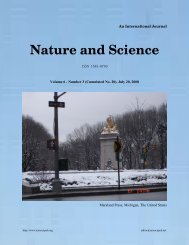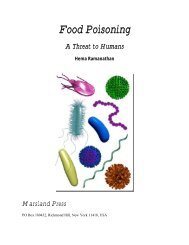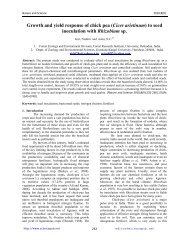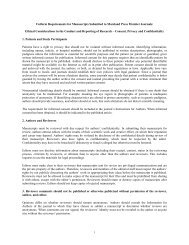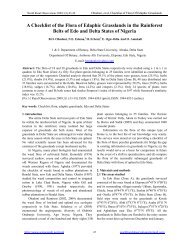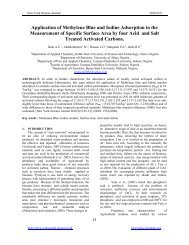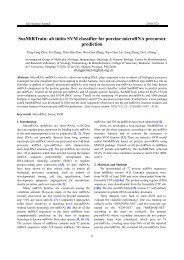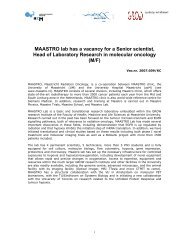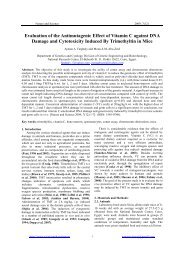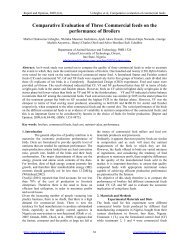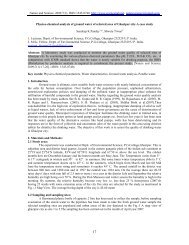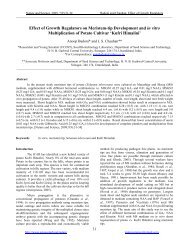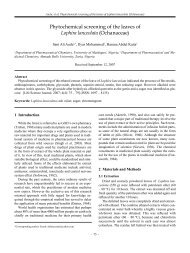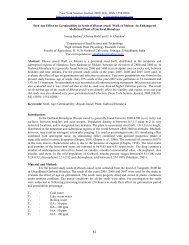Ecological, Social and Commercial Role of Lichens in India with ...
Ecological, Social and Commercial Role of Lichens in India with ...
Ecological, Social and Commercial Role of Lichens in India with ...
Create successful ePaper yourself
Turn your PDF publications into a flip-book with our unique Google optimized e-Paper software.
Acdemia Arena 2010, Supplement 0201<br />
http://www.sciencepub.net<br />
(Everniastrum, Parmotrema, Cetrariopsis <strong>and</strong> Sticta), Cyanolichens (Leptogium), Usnioid (Usnea,<br />
Ramal<strong>in</strong>a) <strong>and</strong> Physcioid (Heterodermia) lichens.<br />
The Physcioid genera hav<strong>in</strong>g larger thallus (Heterodermia diademata) prefer to grow on the<br />
thicker twigs while members hav<strong>in</strong>g smaller sized thallus (H. hypocasia, H. <strong>in</strong>cana, H. leucomela)<br />
grow on th<strong>in</strong> twigs <strong>in</strong> association <strong>with</strong> crustose lichens towards the apex. Q. semecarpifolia st<strong>and</strong>s<br />
<strong>of</strong> diameter class <strong>of</strong> more than 4.0 cm exhibit only the presence <strong>of</strong> Cyanolichens.<br />
Most <strong>of</strong> the Parmelioid genera colonize on all the five diameter classes <strong>of</strong> twigs <strong>and</strong> number<br />
<strong>of</strong> species <strong>in</strong>creases as the thickness <strong>of</strong> the twigs <strong>in</strong>creases, except E. cirrhatum which grows on<br />
th<strong>in</strong>ner branches also. Some species <strong>of</strong> Usnioid lichens prefer th<strong>in</strong> barks towards the distal region<br />
<strong>of</strong> twigs.<br />
Q. semecarpifolia bears the maximum <strong>in</strong>dividuals <strong>in</strong> different diameter classes followed by<br />
Q. floribunda <strong>and</strong> Q. leucotrichophora. The probable reason for dom<strong>in</strong>ance <strong>of</strong> lichens on Q.<br />
semecarpifolia may be the higher altitude as mentioned by Pirentoses et al. (1995), the crucial<br />
factor determ<strong>in</strong><strong>in</strong>g the spatial heterogeneity <strong>of</strong> epiphytes lichens <strong>of</strong> Fagus sylvatica is the altitude<br />
<strong>and</strong> not the height on the trunk at which lichen community is established.<br />
Q. floribunda <strong>and</strong> Q. leucotricophora exhibit the representation <strong>of</strong> only Parmelioid <strong>and</strong><br />
Usnioid lichen communities. Q. leucotrichophora has 3 genera belong<strong>in</strong>g to 3 species <strong>of</strong><br />
Parmelioid <strong>and</strong> 7 species <strong>of</strong> Usnioid lichens while Q. floribunda has 3 species <strong>of</strong> Parmelioid <strong>and</strong><br />
12 species <strong>of</strong> Usnioid lichens.<br />
Out <strong>of</strong> the 38 commercially used lichen species from different states <strong>of</strong> <strong>India</strong>, enumerated<br />
by Upreti et al. (2005), 24 species <strong>of</strong> 15 genera belong to Parmelioid lichens <strong>with</strong> maximum<br />
representation <strong>of</strong> Everniastrum <strong>and</strong> Parmotrema species followed by Usnioid (8 species <strong>of</strong> 2<br />
genera) lichens. Lichen genera Everniastrum, Parmotrema, Rimelia, Parmelaria, Usnea, Lobaria,<br />
<strong>and</strong> Ramal<strong>in</strong>a are exploited exhaustively for their commercial use. Q. semecarpifolia forests are the<br />
best collection sites for these lichens. Shah (1997) <strong>and</strong> Upreti et al. (2005) have documented the<br />
need for protection <strong>and</strong> conservation <strong>of</strong> lichens <strong>in</strong> <strong>India</strong> because <strong>of</strong> their <strong>in</strong>tensive exploitation, but<br />
conservation has not received the desired attention. The less lichen biomass <strong>in</strong> <strong>India</strong> forest as<br />
compared to other European countries further advocate that the trade <strong>of</strong> endangered lichen species<br />
such as Parmotrema nilgherrense, Everniastrum cirrhatum, <strong>and</strong> E. nepalense should be banned <strong>in</strong><br />
83



